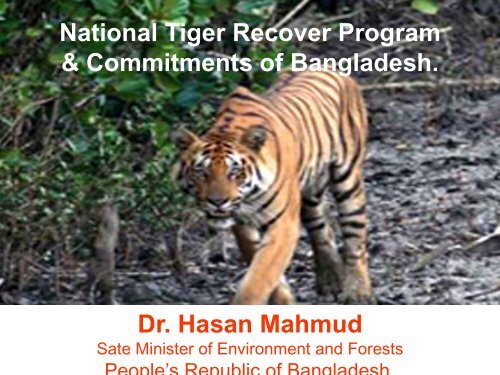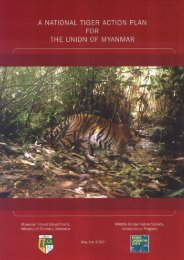National Tiger Recover Program & Commitments of Bangladesh. Dr ...
National Tiger Recover Program & Commitments of Bangladesh. Dr ...
National Tiger Recover Program & Commitments of Bangladesh. Dr ...
- No tags were found...
Create successful ePaper yourself
Turn your PDF publications into a flip-book with our unique Google optimized e-Paper software.
<strong>National</strong> <strong>Tiger</strong> <strong>Recover</strong> <strong>Program</strong>& <strong>Commitments</strong> <strong>of</strong> <strong>Bangladesh</strong>.<strong>Bangladesh</strong> <strong>Tiger</strong> ActionPlan (2009-20017) &AchievementsbyDR. TAPAN KUMAR DEYConservator <strong>of</strong> ForestForest Department<strong>Bangladesh</strong>.Photo<strong>Dr</strong>. Hasan MahmudSate Minister <strong>of</strong> Environment and Forests
Protected Areas in <strong>Bangladesh</strong>
Map Showing <strong>Tiger</strong> Landscape and Vegetation Types in <strong>Bangladesh</strong>
Core Breeding Area
<strong>Tiger</strong>s were found in 11 districts <strong>of</strong> <strong>Bangladesh</strong> Seen up to 1930s Now tigers are confined only in Sundarbans(Total area-10,000 sq km, <strong>Bangladesh</strong>-6017sq.km,23% <strong>of</strong> the total forests) and it has beendeclared as World Heritage Site in 1997) The tigers were lost in other areas due to Habitat degradation Habitat fragmentation Monoculture Encroachment Forest Clearing Legal hunting in the past Illegal poaching <strong>of</strong> tiger and prey
Not simply the loss <strong>of</strong> a big catWhy a focus on tigers?Lose tiger, lose Sundarbans and its ecological services:• Largest mangrove remaining in the world• 44% <strong>of</strong> the remaining forest in <strong>Bangladesh</strong>• Building materials and fuelwood• Helps feed the nation• Prevents the coast from being washed away• Protects villages from cyclones preventing loss <strong>of</strong> human life andcrores <strong>of</strong> damage• Mitigates climate change - produces oxygen and stores carbonThe huge value <strong>of</strong> these benefits remains uncalculated, but investmentin conservation action now, will secure them for this and futuregenerations
<strong>Bangladesh</strong> <strong>Tiger</strong> Population Status.Year Estimated and survey by Method <strong>of</strong> EstimateEstimated<strong>Tiger</strong>Population1975 Bubert HendrichsField survey in compartment in3,4,5,6,29,30,31,46,47,48,49, 501982 Salter Sample field survey 4253501984 Gittins and Akand1992 Forest Department1993 Tamang and dey2004Forest Department andUNDP in collaborationwith Indian expertsField survey in 110 sq. km. area <strong>of</strong>Sundarbans South Wildlife SanctuaryReport <strong>of</strong> the people working inSundarbansPugmark census in 350 sq.km. <strong>of</strong> differentcompartmentPugmark census430-450359362440(including 21cubs)
Prey depletion• Deer poaching and tradeThreats to tigers, tiger prey and SundarbansDirect tiger loss• <strong>Tiger</strong> poaching and trade• <strong>Tiger</strong>-human conflictSundarbans degradation• Sea level rise & Climate Change Effects• Sidor in 2007 & Aila in 2009• Water contamination• Industrial pollution• Polder construction• Non-timber forest product collection• Tree disease• Human pressure on forest resource
Fish drying stands in the south <strong>of</strong> the Sundarbans at Dubla FishermenHut
Human-Wildlife ConflictKilling Incidence <strong>of</strong> a stray <strong>Tiger</strong> in a village nearSundarban
Long Term Strategic Goals• Marginally Increase or stabilize the Sundarbans tigerpopulation by reducing key threats to tigers, prey and habitat.• Maintain sufficient prey base to support the Sundarbans tigerpopulation• Maintain sufficient habitat to support the Sundarbans tigerand prey population• Improve conservation capacity in the FD and mainstream tigerconservation into the GoB's development agenda
<strong>National</strong> <strong>Tiger</strong> <strong>Recover</strong>y <strong>Program</strong>meVisionStabilize ormarginally increasethe current tigerpopulation byreducing some keythreats to tigers,prey and habitat.
Deer Population Estimation in the SRF by Pellet Group Counting &Transect MethodSlNo.Vegetation types Ares (sq. km.) Mean density <strong>of</strong>Spotted Deer(no./sq.km.)Total no <strong>of</strong>Spotted Deer1. Sundri 749.92 3 22502. Sundri-Gewa 1059.73 10 105973. Sundri-Passur-Kankra 95.56 12 11464. Gewa 215.20 12 25825. Gewa-Sundri 757.03 3 45426. Gews-goran-Passur 346.04 15 51907. Goran-Gewa-Keora 648.07 43 278678. Passur-Kankra-Bean 40.30 14 56429. Keora-Gewa open grassland 82.86 174 14417Total79531 (say80,000)Ref. Dey, Tk, 2006, Population Ecology <strong>of</strong> Deer in SRF
Spotted deer grazing under a stand <strong>of</strong> keora trees
Causality <strong>of</strong> tiger and human in Sundarbans for last ten years isgiven bellow (2000-2009) :Year Name <strong>of</strong> Forest Division Human killedby tigerKilled byhuman<strong>Tiger</strong> killed/diedDied due to oldage/ diseaseTotalComment’s2000 Sundarban ForestDivision2001 Sundarban ( West andEast)30 5 - 5 tiger incidence and livestock killingwas not recorded.19 1 2 3 -do-2002 -do- 28 3 - 3 -do-2003 -do- 21 4 - 4 -do-2004 -do- 15 3 - 3 -do-2005 -do- 13 0 1 1 -do-2006 -do- 6 0 1 1 -do-2007 -do- 10 3 1 4 -do-2008 -do- 21 1 1 2 65 tiger incidence occurred ; 3persons were injured and 32livestock was killed.2009 -do- 30 3 - 3 58 tiger incidence occurred; 1persons were injured and 4 waslivestock was killed.2010(Up toSeptember)-do- 26 2 - 241 tiger incidence occurred; 9 persons wereinjured and8 was livestock was killed.Total …… 193 23 6 29
<strong>National</strong> <strong>Tiger</strong> <strong>Recover</strong>y <strong>Program</strong>mesCollaborationInstitutional development and policyForest protection and law enforcementEducation and awarenessResearch and monitoring<strong>Tiger</strong>-human conflict
<strong>Tiger</strong> Conservation AchievementsInstitutional development and policy• Strengthening Wildlife Management & othersForest Divisions , Khulna & Bagerhat.Forest protection and law enforcementEducation and awareness• Regional IDA Project (SRCWP),• SRF Protection Assessment (input into EC SEALS design)• New Wildlife Act-2010 is in vetting process• Training to local people by FD & WTBResearch and monitoring• <strong>Tiger</strong> (khal) survey by WTB<strong>Tiger</strong>-human conflict• FD tiger response team training for each range• Village tiger response team training• Compensation policy for WHC mitigation-2010Collaboration• WB, UNESCO, WTB,ZSL, UNDP & FD startedseveral project focusing tiger conservation
<strong>Tiger</strong> Conservation Plan for 2010-11Institutional development and policyForest protection and law enforcementEducation and awareness• Regional IDA Project (<strong>Bangladesh</strong>, Bhutan, Nepal & India)• Wildlife circle strengthening - revise organogram, wildlife center,budgetary allocations• Wildlife crime control unit development• Eco-tourism Plan• Enactment <strong>of</strong> Wildlife Act-2010 and revise Forest Act1927.• EC SEALS project commencement• Regional IDA Project (<strong>Bangladesh</strong>, Bhutan, Nepal &India)• <strong>National</strong> tiger conservation awareness and educationstrategy, media campignResearch and monitoring<strong>Tiger</strong>-human conflictCollaboration• NTRP & BTAP research agenda, tiger abundance survey• Prey poaching survey• Chittagong hill tracts survey• <strong>Tiger</strong> capture and immobilization training• <strong>Tiger</strong>-human conflict compensation policy-2010• More village tiger response teams• Global <strong>Tiger</strong> Initiative, GTF• co-management options• transboundary conservation initiatives with India
Priority Actions to Achieve Goals• 1.Bulding Institutional Capacity• To develop capacity in the Forest Department for effective wildlife and habitatconservation;• capacity building and training;• logistical support ;• reorganization & recruitment ;• wildlife crime control unit ;• wildlife wing ;• wildlife center ;2.Engaging local communities• To reduce community dependency on forest resources through alternative incomegeneration and co-management• To involve local communities and administrations in forest management throughco-management process;• To reduce tiger-human conflict through tiger response team• To reduce tiger human conflict through compensation• To reduce tiger and prey species poaching and consumption through communityledanti poaching programme ;• To reduce tiger and prey poaching through awareness campaigns
3. Habitat Protection• To deploy an effective and efficient cadre <strong>of</strong> wildlife conservation field staff to conservetigers and tiger habitat;• Create wildlife conservation wing with sufficient manpower• Provide logistical support• Strengthening PA Management in Sundarban4. Trans-boundary collaboration with India on illegal trade.• Develop Protocol for tiger conservation in trans-boundary area between <strong>Bangladesh</strong> andIndia.• Collaboration to curb cross-border poaching, smuggling• Sharing <strong>of</strong> tiger conservation knowledge and practices5. Policy Framework• Revise and enact Wildlife (Conservation) Act-2010• Protocol to address and mitigate tiger- human conflict• Update co-management rules• Delegated wildlife conservation unit• Inter-Ministerial Policy decisions are needed to strengthen Wildlife Crime Control Unit incollaboration with police, BDR, Coast Guard.
Thank you
















